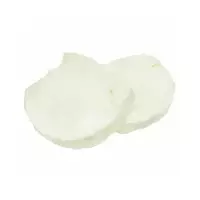Goat cheese

Asia is considered the birthplace of goat cheese, where it has been produced for a very long time, and only in the 13th century it was learned about in European countries. The recipe for making this cheese brought by the Moors was the first to be appreciated by the ancient Romans, after which the victorious procession of this product began in many European countries. In those days, goat cheese was not considered a delicacy, it was customary to consume it in large quantities for breakfast, lunch and dinner. Today, goat's milk cheese is not a cheap dish. Interestingly, the leadership in the production of this delicious delicacy belongs to France, the country of the richest cheese traditions.
Many types and varieties of goat cheese stand out, which differ mainly in the degree of aging. For example, young goat milk cheese has a snow-white color and a tender taste. The older the dairy product, the denser its structure and the stronger its specific "goat" taste. The calorie content of goat cheese is 290 kcal per hundred grams.
Fresh and semi-soft types of cheeses melt wonderfully and are suitable for grilling, as well as a variety of snacks and salads. Goat cheeses with a stronger aroma are recommended to be used in moderation. All cheeses made from goat's milk must be stored hermetically packed in a box or plastic bag.
The benefits of goat cheese
First of all, the benefit of goat cheese lies in the presence of lactic acid bacteria. After conducting numerous studies and DNA analysis, it was found that these organisms are completely similar to those that are an integral part of "live" yogurts. Interestingly, almost all varieties of this cheese contain these lactic acid bacteria. Their number ranges from 107-109 units per 1 gram of product, and the content of lactic acid bacteria reaches 99 percent.
The value of these microorganisms is as follows: they cause fermentation processes in lactose and oxidize the ROP factor, thereby creating an obstacle to the emergence and reproduction of pathogenic sticks. Thus, in its composition, goat cheese, which has an antibacterial property, is in many ways similar to antibiotics.
In addition, the benefits of goat cheese are also that its nutritional properties are much higher than the value of a product made from cow's milk. It is better absorbed by the human body without causing allergic reactions. In addition, goat cheese has twice as much vitamin A, and its regular consumption has a favorable effect on the condition of bones, teeth and blood pressure.
goat cheese 290 kCal
Energy value of goat cheese (Ratio of proteins, fats, carbohydrates - ju):
Proteins: 21.3 g (~ 85 kCal)
Fats: 21.7 g (~ 195 kCal)
Carbohydrates: 0.7 g (~ 3 kCal)
Energy ratio (bj | y): 29% | 67% | 1%
 Español
Español Français
Français Português
Português Русский
Русский 简体中文
简体中文 繁體中文
繁體中文 日本語
日本語 한국어
한국어 العربية
العربية Türkçe
Türkçe Қазақ
Қазақ Deutsch
Deutsch Italiano
Italiano Українська
Українська
